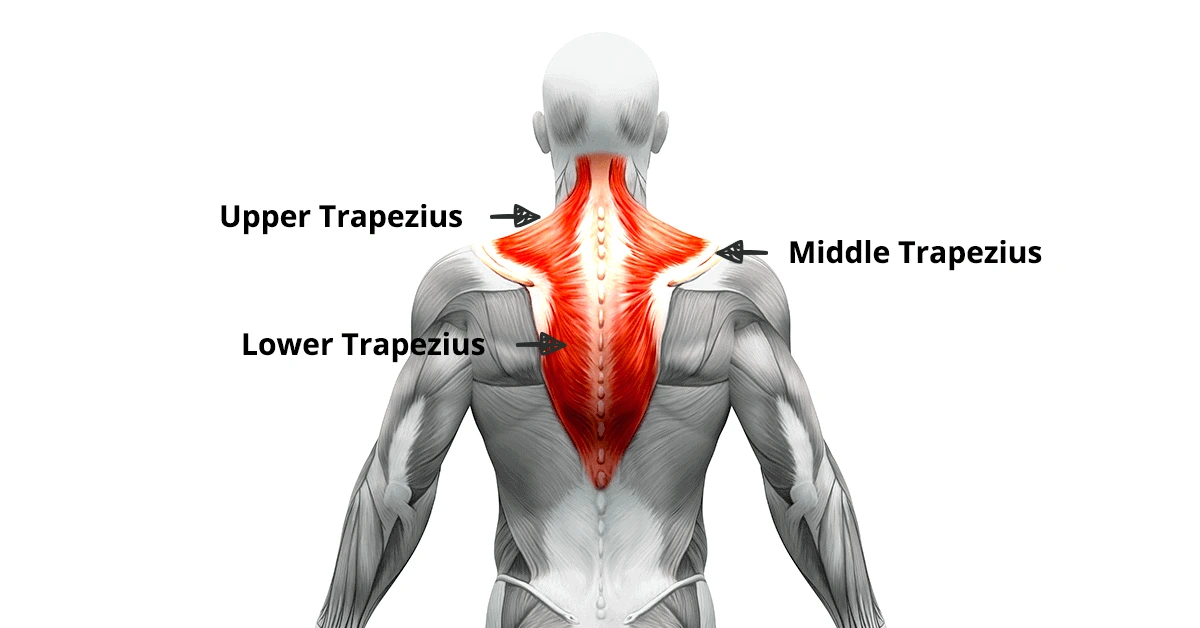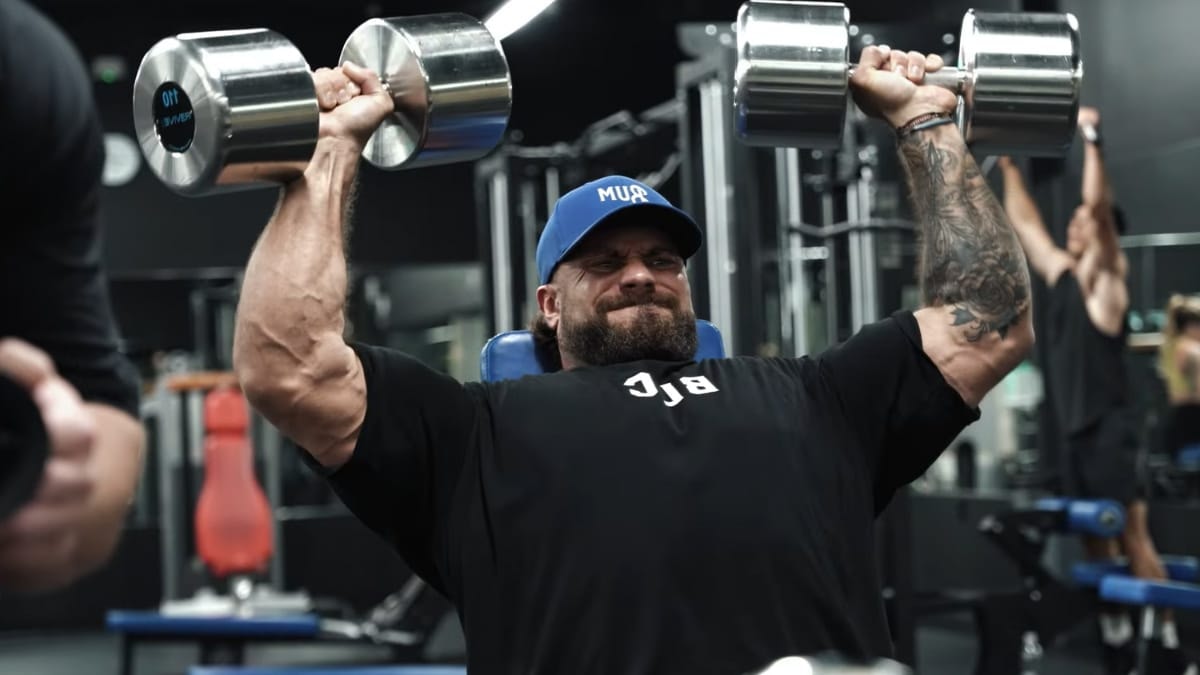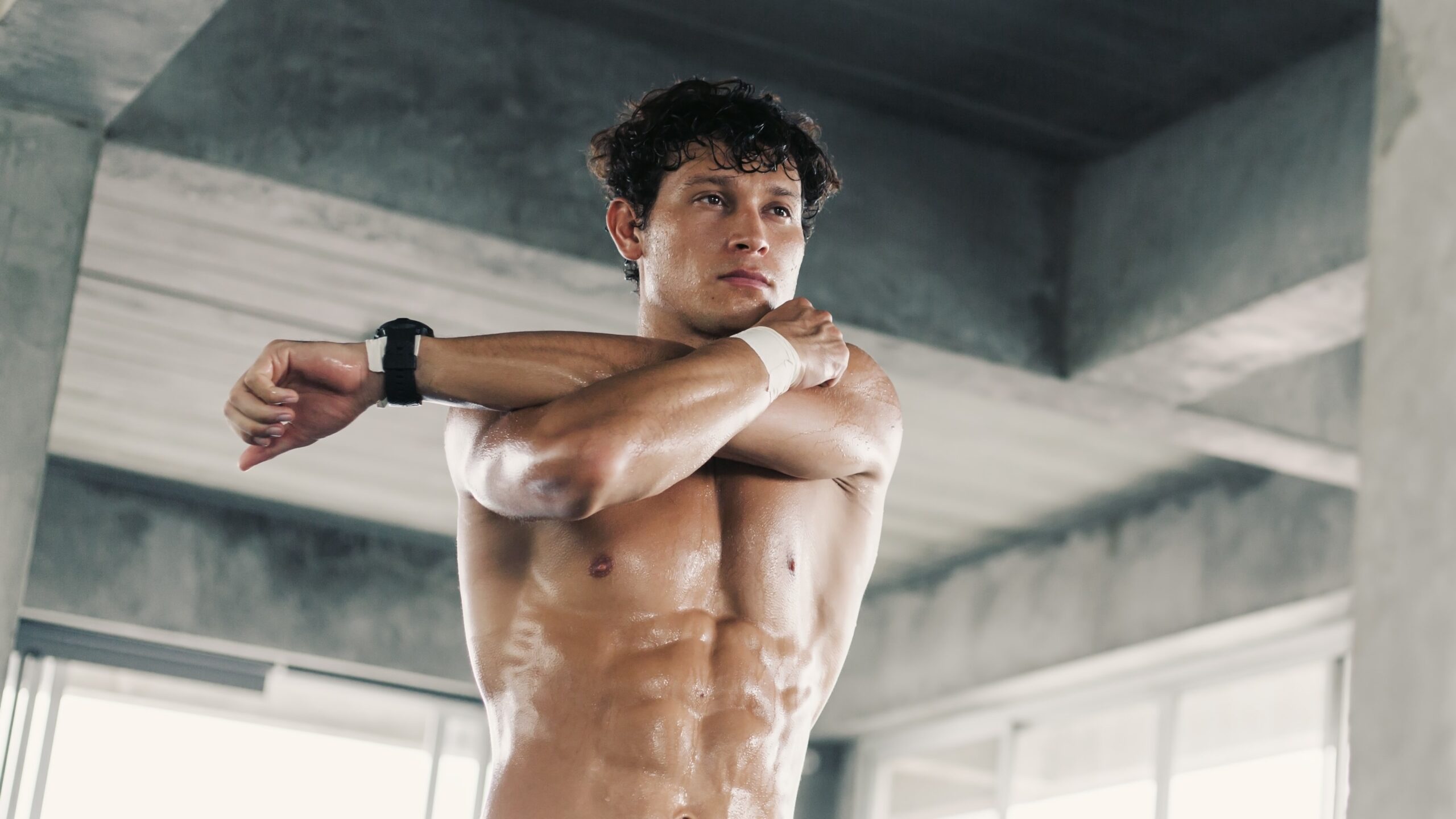When I first got into strength training, I just lifted weights and didn’t really know much about the actual anatomy of my shoulders. This can work, no doubt, but once I learned and understood shoulder muscle anatomy, I made huge gains in the gym in both the muscle and strength department.
Knowing what is going on in the shoulder complex is a real cheat code not just for gains in the gym, but for preventing injuries and perfecting your form in different exercises.
For more on the shoulders, read our lists of the 14 Best Shoulder Exercises for Mass and Strength in 2024, and the 7 Effective Bodyweight Exercises for Stronger Shoulders.
Understanding the Shoulder Complex
The shoulders are a complex part of your upper body that really makes sure everything goes smoothly. They’re involved in almost every upper body movement, and knowing how they work will really help you in the gym.
The glenohumeral joint, often referred to as the shoulder joint, is one of the most mobile and complex joints in the body, allowing for a wide range of motion, but its complexity also makes it prone to injury.
If you really want to make the most out of shoulder exercises, you need to know the anatomy of the muscles and how they all work together. It will take your mind-muscle connection to another level.
Detailed Location of Shoulder Muscles
Understanding the precise locations of the shoulder muscles is crucial for both fitness enthusiasts and individuals in rehabilitation.
The shoulder is a ball and socket joint, meaning the rounded head of the arm bone fits into the shallow socket of the shoulder blade, enabling extensive mobility.
Here’s a closer look at where each key muscle group in the shoulder is situated:
Deltoids

Situated on the highest part of the arm, right on the top of the shoulder, the deltoids are easily the most prominent shoulder muscles, visible even under a thin layer of clothing.
They form a rounded, triangular shape that covers the shoulder joint on three sides.
The deltoid is divided into three heads:
- Anterior Deltoid: Located at the front of the shoulder
- Lateral Deltoid: Found on the side of the shoulder
- Posterior Deltoid: Positioned at the back of the shoulder
The deltoid muscle is a key player in shoulder movement, helping lift, rotate, and stabilize the arm during various activities. If you hear a gym-bro talking about shoulder muscles and shoulder exercises, he is referring to the deltoids.
Rotator Cuff

The rotator cuff consists of four smaller muscles deeply embedded within the shoulder, surrounding the joint. They secure the head of the upper arm bone firmly within the shallow socket of the shoulder blade.
The rotator cuff also works with the biceps tendon, which connects the biceps brachii to the shoulder joint, helping with arm flexion and shoulder stability.
The rotator cuff tendons attach these four muscles to the shoulder blade and upper arm, helping with the stability and movement of the joint.
- Supraspinatus: Found at the top of the shoulder blade, lying beneath the trapezius.
- Infraspinatus: Located across the back of the shoulder blade.
- Teres Minor: Sits just below the infraspinatus.
- Subscapularis: Found on the front side of the shoulder blade, covered by the rib cage.
Trapezius

This muscle spans a large area across the back of the neck and shoulders, extending down to the middle of the spine.
It is divided into three parts:
- Upper Trapezius: Starts from the back of the neck.
- Middle Trapezius: Stretches across the upper back.
- Lower Trapezius: Extends downward to the center of the back.
The serratus anterior also works alongside the trapezius to stabilize the shoulder blade, which is essential for efficient upper limb movement.
Teres Major
![Figure, Teres Major and Minor Image courtesy S Bhimji MD] - StatPearls - NCBI Bookshelf](https://youreverydayfitness.com/wp-content/uploads/2024/12/terest__minor.jpg)
Located just below the shoulder blade, the teres major runs from the lower edge of the scapula to the upper portion of the upper arm bone.
The teres major often works together with the pectoralis major (the biggest chest muscle) during movements that involve pulling or pushing the arms.
It is also often involved with the latissimus dorsi muscle, which is why it’s sometimes referred to as the “little lat.”
Functions of the Different Shoulder Muscles
Every one of these muscles has its own specific job in shifting and stabilizing the shoulders. Knowing what each muscle does will help you exercise the entire shoulder complex correctly.
Deltoids
- Front Deltoid: Primarily responsible for shoulder flexion, moving the arm forward.
- Side Deltoid: Facilitates arm abduction, which is raising the arm to the side.
- Back Deltoid: Primarily responsible for shoulder extension, a.ka. pulling the arm backward.
Rotator Cuff
- Supraspinatus: This muscle initiates the first 15 degrees of arm abduction (away from the body’s midline) before the deltoids take over.
- Infraspinatus: The infraspinatus muscles are mainly responsible for externally (away from the body) rotating the arm, allowing for movements like reaching behind.
- Teres Minor: Works together with infraspinatus to externally rotate the arm.
- Subscapularis: The largest of the rotator cuff muscles, it internally rotates (toward the body) the arm and stabilizes the shoulder during movement.
Trapezius
- Upper Section: Lifts the scapula, which is necessary for movements such as shrugging.
- Middle Section: Retracts the scapula, drawing it towards the spine, crucial for pulling actions.
- Lower Section: Depresses the scapula, moving it downward and assisting in overhead lifts.
Teres Major
- Works to medially rotate and adduct the arm, pulling it towards the body’s midline and turning it inward.
Exercises to Target Each Muscle

Properly exercising each of these muscles will enhance shoulder strength, flexibility, and prevent injuries. If you exercise each muscle of the shoulder, you will have a really strong and stable shoulder that has no flaws, which is uncommon!
Here are some effective exercises for targeting each muscle group:
Deltoids
- Front Deltoid: Front raises using dumbbells, cables, or resistance bands.
- Side Deltoid: Lateral raises, preferably with dumbbells, but also cables with a handle. Read our guide on side deltoid exercises for more.
- Back Deltoid: Standing or bent-over reverse flyes with dumbbells or cables. Also, reverse pec deck machine flyes, or cable pull aparts.
Rotator Cuff
Most rotator cuff exercises are for stability, rehabilitation, and injury prevention.
- General: Rotator cuff exercises are best done with light weights or resistance bands. Perform internal and external rotations to strengthen all four muscles.
- Specific: Cable external rotations for infraspinatus and teres minor; doorway stretch and resistance band internal rotations for subscapularis.
Trapezius
- Upper Trapezius: Shoulder shrugs with barbells or dumbbells.
- Middle Trapezius: Seated or bent-over rows, focusing on squeezing the shoulder blades together.
- Lower Trapezius: Reverse cable flyes or prone horizontal abductions with light weights.
Teres Major
- Target this muscle with exercises like single-arm dumbbell rows and pullovers that emphasize shoulder adduction and internal rotation.
By first recognizing what each muscle does, you can pick the right exercises to hit them. For example, you know that the side deltoid helps lift the shoulder away from the body, so if you do lateral raises, you know you are exercising that muscle in the perfect way!
Mixing up the exercises and focusing on what each muscle does will really help your shoulder muscles grow, and keep you away from injuries. Make sure to do a proper shoulder warm-up routine before lifting weights—keeping your muscles loose and ready is key.
Common Shoulder Injuries
Many common shoulder muscle injuries, such as rotator cuff tears or impingement, result in persistent shoulder pain that can affect your daily activities and workouts.
I tore my rotator cuff muscles years ago and it is an injury that will stay with you for way too long if you don’t take care of it properly. The best way to take care of an injury is to avoid it all together.
The glenohumeral ligaments (shoulder ligaments) can become easily strained or damaged during activities that involve repetitive overhead movements or sudden impacts, which occurs often during exercise.
Learning more about the anatomy of the shoulder and doing proper exercise will make a huge difference for you in that regard.
Here are five of the most common shoulder injuries:
- Rotator Cuff Tear: This injury involves a tear in one or more of the rotator cuff muscles, often due to repetitive motion or sudden strain. Symptoms include pain and weakness in the shoulder, as well as the inability to rotate the shoulder. Rotator cuff injuries, such as tears or rotator cuff tendonitis, are common among athletes and weightlifters, often caused by overuse or improper form.
- Impingement Syndrome: Occurs when the rotator cuff tendons are pinched during shoulder movements. This can lead to pain and inflammation, particularly when lifting the arm.
- Frozen Shoulder (Adhesive Capsulitis): Characterized by stiffness and pain in the shoulder joint. This injury typically develops slowly, and the exact cause can sometimes be unclear.
- Shoulder Dislocation: The humerus (upper arm bone) pops out of the shoulder socket, often due to a significant force or injury. This is extremely painful and can lead to instability or repeated dislocations.
- SLAP Tear (Superior Labrum Anterior to Posterior Tear): A tear in the ring of cartilage (labrum) surrounding the shoulder socket, often caused by repetitive overhead actions or acute trauma.
If you know how your shoulder’s put together and what might go wrong, you’ve got a much better shot at side-stepping the common injuries. These injuries are no joke, and can last for a lifetime, so take care of those shoulders!
Shoulder Mobility and Flexibility

Importance of Shoulder Mobility
Shoulder mobility is really important if you want to stay fit and injury-free. The shoulder is one of the most complicated joints in the body, and if it doesn’t move right, everything feels off. Mess up your shoulder and you will feel it in almost every single upper body movement. No bueno.
Good mobility isn’t just about making your workouts smoother (although it definitely does that). It also keeps you from getting serious injuries so you can continue to progress.
Stretches to Improve Shoulder Mobility
If you want to keep your shoulders loose and moving well, here are some of my go-to stretches that target bending, rotating, and overall flexibility:
- Shoulder Circles
- Stand tall or sit with a straight back.
- Extend your arms out to the sides at shoulder height, like airplane wings.
- Start making small circles with your arms, moving forward.
- Gradually make the circles bigger, feeling your shoulders loosen up.
- Repeat in the reverse direction.
2. Arm Across Chest
- Extend one arm across your chest at shoulder height.
- Use your opposite hand to gently pull the arm closer to your chest.
- Keep your shoulders relaxed as you hold the stretch for 20-30 seconds.
- Switch arms and repeat.
3. Doorway Stretch
- Stand in a doorway and place your hands and forearms against the frame at shoulder height.
- Step one foot forward and gently lean into the doorway.
- Feel the stretch across your chest and shoulders.
- Hold for 20-30 seconds, then step back to release.
4. Wall Slides
- Stand with your back flat against a wall, feet a few inches away from it.
- Raise your arms into a ‘W’ position, with elbows bent and hands near shoulder height.
- Slowly slide your arms upward into a ‘Y’ shape, keeping them in contact with the wall.
- Lower your arms back to the ‘W’ position and repeat 8-10 times.
5. Thread the Needle
- Start on all fours, with your wrists under your shoulders and knees under your hips.
- Slide one arm underneath the other, twisting your torso until your shoulder and head rest gently on the floor.
- Hold the stretch for 15-20 seconds, feeling the release in your upper back and shoulder.
- Return to all fours and repeat on the other side.
Adding these stretches to your routine will help keep your shoulders flexible, reduce stiffness, and improve overall mobility.
Do them consistently to prepare for workouts and stay injury-free! I make sure to do a full warm-up routine before every single upper body workout. Never miss a day.
Recovery and Maintenance
Self-Care Techniques for Shoulder Maintenance
Taking care of your shoulders isn’t just about stretching or lifting weights—it’s about recovery and smart maintenance.
Here’s what works for me:
- Stretching: Regular stretches keep your shoulders loose and prevent stiffness. Do a solid stretching routine regularly to improve your range of motion.
- Foam Rolling: Great for breaking up tight spots and improving blood flow.
- Cold Therapy: Ice packs help reduce swelling and soothe post-workout aches. Just because you are not injured, doesn’t mean ice isn’t beneficial.
- Heat Therapy: Use heat pads to relax muscles and recover after tough workouts. I regularly use a heat pad on my shoulder muscles when I am relaxing. It takes no effort and really loosens the muscles.
- Massage: Nothing beats a good massage to work out knots and keep everything moving smoothly.
- Proper Diet: Make sure you have a balanced diet that is high in protein to help your muscles recover and grow stronger.
With the right mix of mobility work, recovery strategies, and a little tender lovin care, your shoulders will stay stronger, more flexible, and ready for your workouts. Just remember to keep it simple, and stay consistent.







